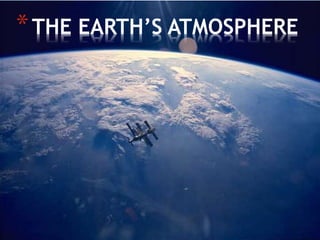
The Earth’s Atmosphere
- 2. *The Atmosphere is a mixture of gasses that sorrounds the Earth and protects us by blocking out dangerous rays from the Sun. It is around 800 Km thick. *Is made up of gasses in different proportions: *78% nitrogen. *21% oxygen. *1% other gasses: argon, carbon dioxide, water vapour, ozone, etc.
- 3. * *There are four layers: *Troposphere *Stratosphere *Mesosphere *Thermosphere
- 5. *Troposphere: *It is 15 Km thick. *It contains 80% of the total mass of the atmosphere. *Here is where the meteorological phenomena occur. *It gets colder with height. *Its upper limit is called Tropopause.
- 6. *Stratosphere: *It is about 30 Km thick. *Its temperature increases with height. *The ozone layer is here: blocks UV radiation from the Sun. *Its upper limit is called stratopause.
- 7. *
- 8. *Mesosphere: *It is about 40 Km thick. *It contains clouds of ice and dust. *It gets colder with heigth. *Its upper limit is called mesopause. *It is here where meteorites desintegrate.
- 9. *Thermosphere: *The highest and the thickest layer. *Its temperature increases to 1.000 ºC due to the X- rays and the gamma rays from the Sun. *It is here where Polar Lights appear.
- 11. *THE WEATHER
- 12. * *The weather describes the state of atmospheric conditions at a certain place, over a short period of time. *Weather conditions include:
- 13. *Wind: movements of air. *Temperature: how hot or cold the air is. *Precipitations: water that falls to the ground: rain, snow and hail. *Humidity: the concentration of water vapour in the atmosphere. *Clouds: formed when air gets cold and condensates. *Atmopsheric Pressure.
- 14. * *Air has weight. *The pressure it exerts on a surface is called Atmospheric Pressure.
- 15. *Where is the pressure going to be highest? *And lowest?
- 17. *
- 18. LOW PRESSURE AREAS They are areas where air rises. So, there is no much air on the terrestrial surface, and the pressure it exerts is low. *As the air rises, it gets colder, condenses, and form clouds. *These clouds will produce precipitations (bad weather). *These areas are also called Squalls.
- 19. HIGH PRESSURE AREAS They are areas where air descends. So, there is a lot of air on the terrestrial surface, and the pressure it exerts is high. *As the air descends, it gets hot and dry, does not condense, and does not form clouds. *So, in these areas we will find good weather. *These areas are also called Anticyclons.
- 21. *CLIMATE
- 22. *Climate describes the weather in an area over a long period of time. *These factors affect climate: *Latitude: how far north or south a place is from the Equator. The Sun heats the most at the Equator, and the least at the Poles.
- 23. *Altitude: the height above the sea level. The higher a place is, the colder it will be.
- 24. *Distance from the sea: *In winter the sea releases heat, keeping coastal areas warmer. *In summer, cold sea keeps coastal areas cooler. So, temperatures are milder in coastal areas than in inland areas.
- 26. *Clouds are formed when rising air cools and condenses to form liquid drops. *Rain occurs when condensation makes large and heavy droplets which fall to Earth. *Snow and Hail occur when the water vapour in the air freezes.
- 27. *There are different types of clouds: -FOG: a cloud in contact with the ground. -CUMULUS: white and puffy clouds that usually mean good weather.
- 28. *CIRRUS: thin and high clouds made of ice crystals.
- 29. *
- 30. *Climate diagrams summarize temperature and precipitation information for a given area. *For one year, we represent each month on the horizontal axis. *Temperature and precipitation are represented on the vertical axis
- 31. *Using your book, look for the correct instrument to measure these phenomena: *The wind direction *The amount of rainfall *The temperature *The wind speed *The humidity *The atmospheric pressure
- 32. THE THERMOMETER The thermometer is used to measure the temperature of the atmosphere.
- 33. THE PLUVIOMETER The pluviometer is used to measure the volume of precipitation.
- 34. THE HYGROMETER The hygrometer is used to measure atmospheric humidity. Atmospheric humidity is the amount of water vapour contained in the air.
- 35. THE ANEMOMETER The anemometer is a device which is used to measure the speed of the wind. THE WEATHER VANE The weather vane is a meteorological instrument we use to measure the speed of wind.
- 36. THE BAROMETER A barometer is an instrument used to measure atmospheric pressure, that is, the pressure exerted by the air. The records of atmospheric pressure in a certain area allow us to establish which are the high pressure areas (anticyclones) and which are the low pressure areas.